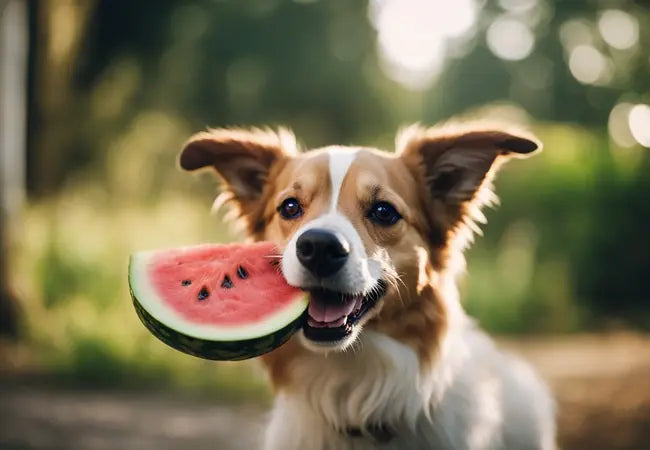Vet‑Approved 2025 Guide: Can Dogs Eat Watermelon? Benefits, Prep & Safety Tips 💉 🐶🍉

In this article
Vet‑Approved 2025 Guide: Can Dogs Eat Watermelon? Benefits, Prep & Safety Tips 💉🐶🍉
By Dr. Duncan Houston BVSc
Summer calls for refreshing treats, and watermelon often tops the list. But is this hydrating fruit safe for dogs? In this Vet‑Approved 2025 guide, Dr. Duncan Houston BVSc explores watermelon benefits, safe preparation, portion guidance, potential risks, and cleanup tools like Ask A Vet, 🐾✨
✅ Health Benefits of Watermelon
- Hydration Hero: Over 90% water—ideal for quenching thirst on hot days.
- Low-Calorie Treat: Only ~46 calories per cup—great for weight-conscious pups.
- Vitamin Boost: Packed with vitamins A, B6, C, and potassium for immunity, eye health & electrolytes.
- Antioxidants & Fiber: Supports digestive and immune health with fiber, lycopene, and beta-carotene.
⚠️ Parts to Avoid & Risks
Not all slices are safe:
- Seeds: May contain trace cyanide and pose blockage risk—remove them.
- Rind: Tough and indigestible—can cause GI upset or obstruction.
- High sugar content: Can spike blood sugar—avoid in diabetic or overweight dogs.
🍽️ Safe Preparation Tips
- Wash the watermelon thoroughly.
- Remove rind and seeds completely.
- Cut flesh into bite-size chunks (~½″).
- Serve fresh or freeze for a cooling snack.
- Avoid sugary products like juice, syrup, or candy-flavored versions.
📏 Ideal Portion Sizes
Treats should stay below 10% of total daily calories:
- Mini (2–10 lb): 1–2 small cubes
- Small (11–20 lb): 2–4 cubes
- Medium (21–50 lb): 5–8 cubes
- Large (51–90 lb): 8–12 cubes
- Extra-Large (90+ lb): Up to ½ cup small pieces.
🕒 Frequency & Serving Ideas
- 1–2 times/week: As a refreshing snack topped on meals.
- Frozen treats: Blend and freeze in silicone molds.
- Mix with yogurt: Use plain, xylitol-free yogurt in puzzle toys.
⚠️ Monitor After Feeding
Watch for changes in stool, appetite, and energy. Stop feeding and consult your vet—or use Ask A Vet—if diarrhea, vomiting, or lethargy occur.
🚫 Who Should Avoid Watermelon
- Dogs with diabetes or weight-control issues.
- Puppies under six months—stick to a vet-formulated diet.
- Dogs with sensitive digestive systems.
🐶 Safe Treat Alternatives
- 🥕 Carrot sticks
- 🍎 Apple slices (seed-free)
- 🫐 Blueberries or sliced strawberries
- 🍉 Seedless cantaloupe or honeydew bits.
🛠️ Vet‑Approved Tools & Support
- Ask A Vet: Get quick advice on dosing, reactions, or emergencies.
- Woopf: Offers interactive treat-dispensing toys and portion-control bowls.
- Purrz: Soothing pheromone diffusers to calm mealtime tension in multi-pet homes.
📅 Sample 8‑Week Feeding Plan
- Week 1–2: Introduce 1 cube; monitor digestion.
- Week 3–4: Increase to 2–3 cubes; add frozen treat once weekly.
- Week 5–8: Use as occasional topper; discontinue if upset arises.
📞 When to Contact Your Vet
- Persistent diarrhea or vomiting
- Bloating, discomfort, refusal to eat or drink
- Concern about sugar impact on health
- Use Ask A Vet for real-time support.
🏁 Final Thoughts
When served properly—seedless, rind-free, in small portions—watermelon is a hydrating, low‑calorie summer treat packed with nutrients. Always keep treats below 10% of daily calories, monitor your dog’s response, and use support tools like Ask A Vet, to make snacking safe, fun, and stress-free. Cheers to a juicy, healthy pup this summer! 🍉🐶❤️






